Connecticut Warbler
A species of Connecticut Warbler Scientific name : Oporornis agilis Genus : Connecticut Warbler
Connecticut Warbler, A species of Connecticut Warbler
Botanical name: Oporornis agilis
Genus: Connecticut Warbler
Description
The eye ring forest singer has an olive top plumage and a dull yellow underside plumage. In the male, the head, throat and upper chest are gray; in the female these spots are brownish. Around the eyes they wear a white eye ring and their beaks are thin and pointed. Her legs have a light pink color.
Size
14 cm (5.5 in)
Life Expectancy
4-6.6 years
Nest Placement
Ground
Clutch Size
3 - 5 eggs
Incubation Period
1 brood
Feeding Habits
Connecticut Warbler primarily consumes insects, including larvae and eggs, spiders, and other arthropods. It forages on the ground, probing soil and leaf litter, and in treetops when insects are abundant. Connecticut Warbler may also ingest berries and seeds, and during migration, can be solitary or join mixed-species flocks.
Habitat
Connecticut Warbler is generally found in lower elevation open woods, with a preference for wetland bogs, sedge meadows, and areas with poor soil drainage. During breeding, it favors dense underbrush in oak-jack pine forests and swamp edges with conifers. It utilizes various plants such as willow and tamarack, seeking dense undergrowth habitats up to 6,600 feet for migration and wintering.
Nest Behavior
The timing of connecticut Warbler's nest building and egg-laying is not specified, but they display typical warbler parental care, with both parents involved in the raising of the young, which includes feeding and protection.
Nest Characteristics
Connecticut Warbler's nest is typically a ground-level cup of grasses, leaves, weeds, sedges, fine roots, and hair, averaging 5 inches in diameter and 2.2 inches tall, with an interior spanning 2 inches across and being 1.5 inches deep, and is well hidden in dense undergrowth or thickets.
Dite type
Insectivorous
Migration Overview
As mentioned earlier, the Connecticut warbler is an elusive species. Little is known about it outside of the breeding season as to this date, less than 25,000 individuals have been banded. These birds migrate to the Amazon Basin in South America in winter. Specimens have been observed in Colombia (north & southeast), Venezuela (northeast & interior), Guyana (at the border), and Peru (South). Connecticut warblers undertake different migratory routes in spring and in fall, an atypical behavior. In spring, they normally pass through the Midwest and only rarely migrate to the East coast, but in fall, larger numbers of migrating birds move through the East coast. Recently, the use of small tracking devices have enabled scientists to gather more data on the warbler's migration routes. They have discovered some individuals fly over open water like the Blackpoll warbler. More specifically, they recorded a previously undocumented two day flight over the Caribbean to the Antillean islands. This correlates with sightings of Connecticut warblers that have occurred in Bermuda, St Thomas and St Martin.The island of Hispaniola is also a popular stop as it is rather remote due to past humanitarian crises. There, they make a minimum of 48 hour stop (it usually lasts 5–7 days) in the Caribbean. This long migration over open water calls for strong selective pressures. A comparative study between the Connecticut warbler and the Blackpoll warbler could help determine what selective pressures are present in these two species. This kind of migration also demands large reserves of fuel and this is why fat Connecticut warblers can be found on the East coast in early fall. It's also the reason why they make several stopovers on their way South.
General Info
Feeding Habits
Bird food type
Bird Feeder Type

Platform
Behavior
Connecticut Warbler exhibit a territorial nature, especially males during the breeding season as they defend their ground of up to 1.25 acres through countersinging and chasing rivals. Their flight is swift, reminiscent of thrushes. Both parents are actively involved in feeding their offspring in a ground-built, well-hidden nest. To avoid drawing predators' attention, they approach the nest with caution, landing away and walking undercover to it. Foraging resembles that of Ovenbirds or Spotted Sandpipers, with a characteristic tail bob. Post-fledging, family units remain together and may join others pre-migration.
Species Status
Not globally threatened.
Scientific Classification
Phylum
Chordates Class
Birds Order
Perching birds Family
New world warblers Genus
Connecticut Warbler Species
Connecticut Warbler 